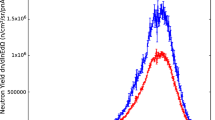Abstract
An accelerator driven system has been studied by irradiation with 20 MeV electrons. Slow, intermediate and fast neutrons were measured by activation and Solid State Track Detectors. The total neutrons emitted from the target were 0.005 per electron, equally divided to slow and intermediate-fast energy regions. An agreement was presented between experimental results and simulations using the GEANT 4 code. The transmutation efficiency of 238U has been estimated as1.04 (± 0.09) × 10−7 per U-gram. Furthermore, the neutron total cross section of natPb was estimated 9.4 ± 1.8 b for fast neutrons and 6.0 ± 0.7 b for slow-intermediate neutrons.





Similar content being viewed by others
References
Fraser JS et al (1965) Neutron production in thick targets bombarded by high energy protons. Phys Can 21:17–18
Vasil’kov RG et al (1968) Neutron yields and thermal neutron fluxes in a lead-water system bombarded by high energy protons. Atomnaya Energiya 25:479–483
Bowman CD et al (1992) Nuclear energy generation and waste transmutation using an accelerator driven intense thermal neutron source. Nucl Instrum Methods A 320:336–367
Carminati F et al (1993) An energy amplifier for cleaner and inexhaustible nuclear energy production driven by a particle beam accelerator. Print CERN/AT/93-47, CERN, Geneva
Andriamonje S et al (1995) Experimental determination of the energy generated in nuclear cascades by a high-energy beam. Phys Lett B 348:697–709
Pienkowski L et al (1997) Neutron multiplicity distributions for 1.94 to 5 GeV/c proton-, antiproton-, pion-, kaon-, and deuteron-induced spallation reactions on thin and thick targets. Phys Rev C 56:1909–1917
Carpenter JM et al (1999) The 10.000.000.000-Volt question: what is the best choice of proton energy to drive a pulsed spallation neutron source? Phys B 270:272–279
Letourneau A et al (2000) Neutron production in bombardments of thin and thick W, Hg, Pb targets by 0.4, 0.8, 1.2, 1.8 and 2.5 GeV protons. Nucl Instrum Methods B 170:299–322
Leray S et al (2002) Spallation neutron production by 0.8, 1.2 and 1.6 GeV protons on various targets. Phys Rev C 65:044621
Gandini A, Salvatores M (2002) The physics of subcritical multiplying systems. J Nucl Sci Technol 39:673–686
Salvatores M, Palmiotti G (2011) Radioactive waste partitioning and transmutation within advanced fuel cycles: achievements and challenges. Prog Part Nucl Phys 66:144–166
Krivopustov MI et al (1997) First experiments on transmutation studies on I-129 and Np-237 using relativist protons of 3.7 GeV. J Radioanal Nucl Chem 222:267–270
Brandt R et al (1999) Transmutation studies using SSNTD and radiochemistry and the associate production of secondary neutron. Radiat Meas 31:497–506
Adam J et al (2006) Transmutation studies with GAMMA-2 setup using relativistic proton beams of the JINR Nuclotron. Nucl Instrum Methods A 562:741–742
Barber WC, George WD (1959) Neutron yields from targets bombarded by electrons. Phys Rev 116:1551–1559
Findlay DJS (1990) Applications of photonuclear reactions. Nucl Instrum Methods B 50:314–320
Brolly B, Vėrtes P (2004) Concept of a small-scale accelerator driven system for nuclear waste transmutation, part 1: target optimization. Ann Nucl Energy 31:585–600
Brolly B, Vėrtes P (2005) Concept of a small-scale accelerator driven system for nuclear waste transmutation, part 2: investigation of burnup. Ann Nucl Energy 32:417–433
Gulevich A et al (2008) Concept of electron accelerator-driven system based on subcritical cascade reactor. Prog Nucl Energy 50:347–352
Zuokang L et al (2013) The conceptual design of electron-accelerator-driven subcritical thorium molten salt system. Energy Procedia 39:267–274
Polański A et al (2015) Neutrons production in heavy extended targets by electrons of energy from 15 to 1000 MeV. Prog Nucl Energy 78:1–9
Tziaka C et al (2018) Application of passive methods for electron flux measurements regarding to 238U electron-disintegration studies. J Radioanal Nucl Chem. https://doi.org/10.1007/s10967-018-5925-y
Zamani M et al (2005) Neutron yields from massive lead and uranium targets irradiated with relativistic protons. Radiat Meas 40:410–414
Remy G et al (1970) Heavy fragment emission in high-energy reactions on heavy nuclei. Journal de Physique 31:27–34
Harvey JR et al (1998) The contribution of Eurados and CENDOS to etched track neutron dosimetry. Radiat Prot Dosim 77:267–304
Manolopoulou M et al (2006) Detection of spallation neutrons and protons using natCd activation technique in transmutation experiments at Dubna. Appl Radiat Isot 64:823–829
Zheltonozhsky VO, Mazur VM, Symochko DM, Bigan ZM, Poltorzhytska TV (2012) Investigation of the isomeric states excitation processes for 111Cd and 115Cd isotopes in (γ, n) reaction at the γ-quantum energies in giant dipole resonance region. Yaderna Fizika ta Energetika 13:140–144
Zheltonozhsky VO et al (2012) Investigation of the isomeric states excitation processes for 111Cd and 115Cd isotopes in (γ, n) reaction at the γ-quantum energies in giant dipole resonance region. Yaderna Fizika ta Energetika 13:140–144
Vagena E, Stoulos S, Manolopoulou M (2016) Analysis of improved neutron activation technique using thick foils fro application on medical LINAC environment. Nucl Instrum Methods A 806:271–279
Agostinelli S et al (2003) Geant4—a simulation toolkit. Nucl Instrum Methods A 506:250–303
ENDF/B-x (2018) and the references within. Brookhaven National Laboratory. http://www.nndc.bnl.gov. Accessed September 2018
Sosnin AN et al (2002) Monte Carlo modelling of neutron spectra in the U/Pb-assembly irradiated with protons. Izv RAS Phys Ser 66:1494–1496
Stoulos S et al (2003) Application of activation method on Dubna experimental transmutation set-ups. Appl Radiat Isot 58:169–175
Zamani M et al (2005) Neutron yields from massive lead and uranium targets irradiated with relativistic protons. Radiat Meas 40:410–414
Laptev T et al (2004) Neutron total cross sections of Pb-204, Pb-206, Pb-207 and Pb-208 and the neutron electric polarizability. In: Proceedings of joint institute for nuclear research (JINR) Reports, vol. 10, No. 2003, Dubna, Russia
Schwartz RB, Schrack RA, Heaton II HT, (1974) MeV total neutron cross sections. National Bureau of Standards Monograph, No. 138, Washington, DC, USA
Author information
Authors and Affiliations
Corresponding author
Rights and permissions
About this article
Cite this article
Stoulos, S., Fragopoulou, M., Vagena, E. et al. Electron accelerator driven system for transmutation studies. J Radioanal Nucl Chem 318, 1209–1217 (2018). https://doi.org/10.1007/s10967-018-6218-1
Received:
Published:
Issue Date:
DOI: https://doi.org/10.1007/s10967-018-6218-1




